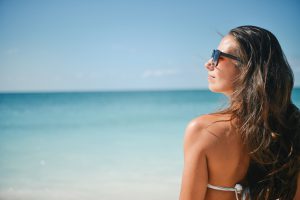 We’ve all heard it a thousand times: wear sunscreen. Every. Day. But it can be overwhelming to know which one to choose. Walk into any drug store and you’ll be confronted with a multitude of brightly colored bottles with various “active ingredients” and SPFs.
We’ve all heard it a thousand times: wear sunscreen. Every. Day. But it can be overwhelming to know which one to choose. Walk into any drug store and you’ll be confronted with a multitude of brightly colored bottles with various “active ingredients” and SPFs.
A new study found that 40% of the top consumer-rated sunscreens sold on Amazon.com didn’t meet the American Academy of Dermatology’s three main criteria: broad spectrum (meaning it protects skin against both UVA and UVB rays), a Sun Protection Factor (SPF) of at least 30 and water-resistant. Researchers found consumers cared more about the product’s smell and consistency than they did about its effectiveness. While completely understandable, this is not good news. Why? Because, prolonged sun exposure is serious stuff. According to the National Cancer Institute, every year approximately 5.5 million Americans develop nonmelanoma skin cancer. Luckily, when discovered early, it’s generally treatable and rarely spreads to other parts of the body. But, obviously prevention is a much-preferred approach.
Conflicting opinions abound about some commonly used sunscreen ingredients, including retinyl palmitate, avobenzone and oxybenzone, for which red flags have been raised. Zinc oxide, a natural, mineral compound, is more photostable than some chemical ingredients that may degrade during sun exposure. Zinc also reflects and reduces the broadest range of UVA (aging) and UVB (burning) ultraviolet rays. Zinc is considered safe for even the most sensitive skin types. (EltaMD, a brand Serenity MedSpa recommends, uses zinc in its sunscreens.)
For more detailed, expert guidance, each year the Environmental Working Group releases a lengthy list of its top picks for healthy sunscreens. Check it out along with Consumer Reports recommendations. And as a general rule, always check the list of ingredients for anything you put on your skin.
Keep in mind that sunscreen alone is not enough to save our skin. Here’s a list of tips to boost your sun protection:
- Limit your exposure.
The sun is strongest between 10 a.m. and 2 p.m. If you’re out and about during peak hours, wear a broad-brimmed hat, sunglasses and be sure to reapply sunscreen every two hours. Ultraviolet Protection Factor (particularly UPF 30+) clothing also helps.
- Don’t skimp.
Apply a generous amount of sunscreen to your exposed skin about every two hours. Sprays and towelettes may not provide uniform protection or last as long as lotions.
- Choose wisely.
Look for a “broad spectrum” sunscreen that protects against UVB and UVA rays. UVB rays cause sunburn and skin inflammation, while UVA rays are largely responsible for skin aging and wrinkling. Both UVB and UVA rays can cause skin cancer.
- SPF matters.
SPF tells us the amount of ultraviolet (UV) radiation exposure it takes to cause sunburn when we’re wearing sunscreen compared to how much we’d burn without it. SPF 15 blocks 93% of UVB rays, SPF 30 blocks 97% and SPF 50 blocks 98%. All of them need to be reapplied every few hours to guarantee protection. Only broad-spectrum sunscreens with an SPF value of 15 or higher can claim to reduce the risk of skin cancer and early signs of aging.
